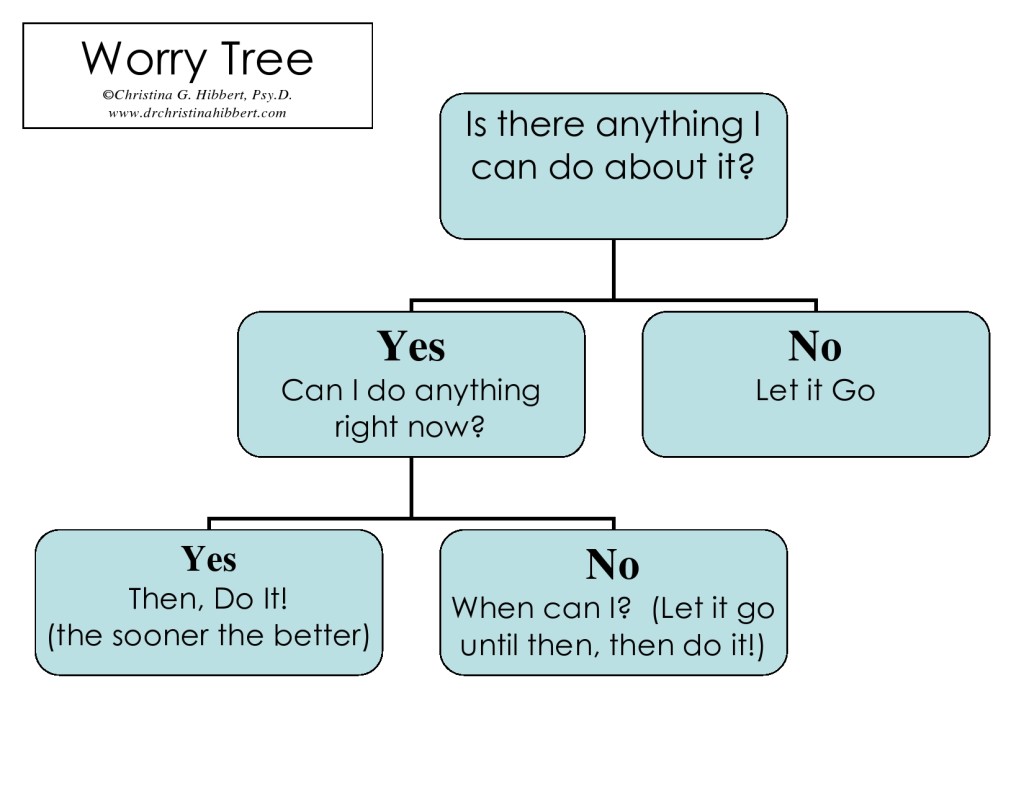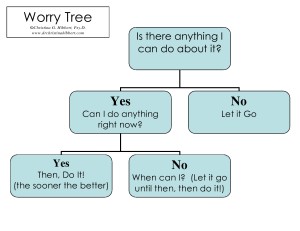
03 May The Key to Worry-Free: The Worry Tree
What’s the Key to Worry-Free?:
The Worry Tree
I got up at 5 on Monday morning to work on my book before the kids woke up. 30 minutes in I was feeling terrific about my writing “flow” when my computer suddenly went blank and a warning came up: “Critical Error!” I tried not to panic as I called tech support, reminding myself that I at least had a backup drive with most of my work from the past 5 years saved on it. The tech guy told me I’d contracted a mega virus; “one of the very worst,” he said. I handled it pretty well until I realized seven hours later that our attempt to save my computer files had failed and that my backup drive had somehow been deleted!
Why Worry?
We’ve all experienced times like this or worse when we feel the panic of a “critical error!” and find it near impossible to stop the endless stream of worries, fears, and anxieties. But at some point we must learn to accept the truth about worry: Worry is not only pointless, it can actually be harmful! I always say, “Worry is good for nothing,” and I believe it. Worrying is a form of avoiding making a decision or taking action. Instead of acting, we en-act the scene over and over in our minds, thus increasing our discomfort and wasting our time. Worrying can also lead to unnecessary harmful behaviors like eating or drinking too much or falling into despair or depression–behaviors that could have been avoided if the worry could have been stopped. In fact, does it ever really help to worry? No. Isn’t it better to either do something about it or let it go? The answer is yes. But the question, then, is how?
The Worry Tree
I’ve created a simple method I call the “Worry Tree.” Remember, worry is simply a feeling, albeit a powerful feeling, and the only good thing we can take from feeling worried is the signal that something needs our attention. The Worry Tree helps us put our attention where it is most productive, alleviating the extra stress and wasted time of prolonged worry.
I’ll give you an example: “My son is not home yet and it’s 15 minutes past curfew! He never does this!” The feeling of worry comes on in full force. The good news is that the worry is putting my attention where it needs to be—on the safety of my child. But there is an underlying assumption feeding this worry too: “Something must be terribly wrong!” Notice how quickly worry jumps to conclusions? And jumping to conclusions can cause all kinds of trouble.
Instead, I’ll use the Worry Tree.
First I ask myself, “Is there anything I can do about this?” If the answer is “No,” if, in our example, my son doesn’t have a cell phone and there is no other way to get in touch with him—then the action I must take is let go of the worry for now and hope for the best. Now, we all know it can be hard to let go of worry, so distracting yourself is a great option. In our example I might remind myself that “it’s only been 15 minutes after all and chances are he’s fine,” then go read a book or finish a project. Then, when he shows up ten minutes later, I’m calm, I’ve alleviated the extra stress of worry, and though there will likely be a consequence for his behavior, he is less likely to get completely reamed.
If, however, I answered “Yes, there is something I can do about this,”–for instance, if my son has a cell phone that I can call—then I ask a second question, “Can I do anything right now?” If the answer is again “Yes,” then we take immediate action; in this case I call my son and learn he will be home soon. Taking action is the best way to alleviate worry, and the sooner we take action, the better.
Many times there is something I can do, but I need to wait to do it (perhaps I need to resolve a situation with a co-worker or friend but they’re not available until next week). When we answer, “No, I cannot do anything right now,” and have to wait to take action, then we must let the worry go until the time when the action can be taken. Again, by pushing worry away until we can do something about our “critical” situation we find that we usually didn’t need the worrisome feelings at all, and we’re much happier in the meantime!
So, Remember…
Worry is simply a way for us to avoid making decisions or taking action. Thus, by taking action and making those decisions worry loses its power. We then begin to see that worry never had any real power anyway—only the borrowed power that we decided to give it. Four days later I’m still waiting for the outcome of my “critical” computer crash, but I’ve kept most of my power by distracting myself away from the worry for the most part (and I have a cleaner house as a result)! So the next time you find yourself worrying, pull out the worry tree and get to work. You will quickly see that the worry tree is the key to being worry-free!
I welcome your thoughts or questions on worrying. Let me know your strategies for being “worry-free” by leaving a comment!
Don’t miss a thing!
SUBSCRIBE, below, and please “like” my Facebook pages (Dr. Christina Hibbert; This Is How We Grow) and follow me on Twitter,Pinterest, & Instagram!
And be sure to check out my Amazon Author Central Page! Join the discussion!
You may manage your subscription options from your profile
Related Articles/Posts
Antidepressant? Or Not?: 12 Facts on Depression & Medication
Women’s Mental Health: 5 Facts Everyone Should Know
5 Tips to Turn a Rainy Day Sunny: Overcoming Feelings of Depression
Women’s Emotions: Introduction
Women’s Emotions: Part 1: The 3 Components of Emotional Health
Women’s Emotions, Part 2: “The Emotional Earthquake“
Women’s Emotions: Part 3, The Menstrual Cycle & Mood
Hormones & Women’s Mental Health (guest post on HealthyPlace.com)
Dr. Christina Hibbert answers: “How do hormones affect women’s mental health?”
5 Reasons “Self-Esteem” is a Myth
If Self-Esteem is a Myth, then What is the Truth?: Understanding Self-Worth
Postpartum Depression Treatment
16 Things I’d Like My Postpartum Self to Know, 16 Years & 6 Kids Later
The 3 Layers of Self-Care: Build a Healthier, Happier YOU!
Mommy Fails & Mother’s Day: 3 Messages Every Mom Needs to Hear
Let’s Get Real: 10 Confessions from ‘The Psychologist, The Mom, & Me’
Why I Feel Like a Loser Mom, & How I Know I’m Really Not


I do agree that women and men tend to worry too much which is a battle I go through from time to time. However, I realize that this affects my body in various way which includes headache and tension. I first recognize my breathing which helps to clear my mind and at times meditate.listening to music also helps to and if I am close to a lake or beach I visit both.
Excellent suggestions, Annmarie. Worry is definitely a physical sensation, and it helps tremendously to do things that calm the body. Thank you for sharing!
[…] Dr. Christina Hibbert: The key to worry-free […]
[…] The Key to Worry-Free: The Worry Tree […]